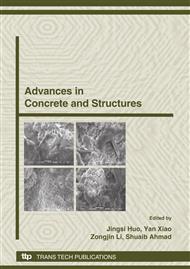p.887
p.893
p.901
p.911
p.917
p.923
p.929
p.935
p.943
Experimental Study on Deep Four-Pile Caps with Different Reinforcement Layouts Based on 3D Strut-and-Tie Analogy
Abstract:
Based on 3D strut-and-tie analogy developed for analyzing the load-transferring mechanism of deep pile cap, this paper focuses on the effect of different longitudinal reinforcement layouts at the lower part of cap on the mechanical behaviors of deep four-pile cap. Besides a common layout of uniformly distributed reinforcement by the flexural theory, three different layouts of concentrated reinforcement over piles were designed by 3D strut-and-tie analogy. All specimens were limited in same reinforcement percentages, dimensions, materials and test procedures. Four specimens with the scale ratio of 1/5 were tested under the statically incremental gravity loading. The load capacity, deflection, strain of longitudinal reinforcement of specimens were measured, and the failure mode, crack propagation, deformation of specimens and stress distribution of reinforcement were analyzed. Through comparisons of the test results among all specimens, it was found that deep pile cap failed in shear and corner-pile punching whether with concentrated or uniform reinforcement, and the reinforcement concentrated over each two adjacent piles, similar to the tension bars in the strut-and-tie model, had considerable advantages than common uniform reinforcement layout. The ultimate strength of deep pile cap with concentrated reinforcement was significantly increased, while the improvement of deformation resistance and brittleness of deep pile cap was limited. According to above findings, the appropriate reinforcement layouts for deep pile cap were suggested in this paper.
Info:
Periodical:
Pages:
917-922
Citation:
Online since:
October 2008
Authors:
Price:
Сopyright:
© 2009 Trans Tech Publications Ltd. All Rights Reserved
Share:
Citation:


